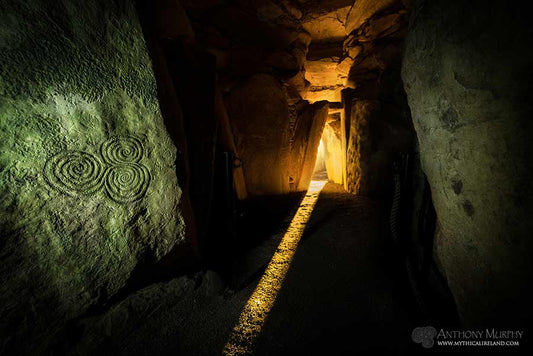
The mysterious 'jumble of stones' under the mound of Millmount, burial place of Amergin
Sophisticated archaeological techniques were unable to determine with any certainty whether the mound supporting the Martello tower of Millmount, Drogheda, could be older than Norman times, as suggested in local folklore.
Drogheda historian Brendan Matthews summarised the findings of the Millmount Archaeological Remote Sensing (MARS) project, which began in 2013 and involved the use of sophisticated non-invasive techniques and equipment, to a public talk in Drogheda on Wednesday 10th July 2019.

A frosty sunrise at Millmount, captured from a drone. © Anthony Murphy
What the remote sensing did reveal, however, is at the very least intriguing, and offers tantalising possibilities. Let’s just say it’s far too early to discount the theory – suggested in the folklore of the area going back to at least the 19th century – that Millmount is the burial place of Amergin, bard of the Milesians, who according to a myth in the Lebor Gabála (Book of Invasions), landed at the Boyne Estuary when he and his brothers came to take Ireland from the Tuatha Dé Danann, the ruling deities closely associated in myth with the great monuments of Brú na Bóinne.
Although the results of the MARS surveys were never published in an academic journal, Mr. Matthews was given summaries of the findings by some of those who had been involved.
He said there appeared to be three layers to the mound of Millmount. From the base up to a height of about 3.5m to 4m (approximately 13ft), the mound consists of a hardened or compact clay. This base layer had what Brendan described as an “outer crust”, leading to speculation that this layer might represent a ringfort, or even a Bronze Age ring-barrow.
Above this first “layer”, extending another 5m above it, is a layer containing different substances – soils with stones and gravel, or, to quote Brendan Matthews, “what Norman mottes are made of”.
Out of some 17 Norman mottes that have been excavated in Ireland, eight of them were found to have been constructed on top of existing mounds.
“Why would the Normans build a new mound, if there was one there already?” Brendan asked.
The second layer of gravel and stony material rises to about 2m from the summit of the mound.
The top 1.5m to 2m of the mound was completely different again, consisting of many different features including trenches, hollows, and some large stones.
Fascinatingly, Brendan recalled how, in the base layer of Millmount, about 65ft inside the mound, towards the centre, there is what he described as a “jumble of stones”. The area covered by this jumble of stones is around 10m2 – too big, perhaps, for a Bronze Age cist grave, upon which one might imagine a barrow being built.

The mound of Millmount retains its archaeological secrets.
The stones could be natural bedrock. The only way to ascertain the true nature of what lies beneath Millmount is to carry out an archaeological dig, he said, but this might never happen because of the Martello tower atop the mound.
The tradition associating Millmount with the burial place of Amergin could only be traced back in documentary form to John D’Alton’s history of Drogheda, published in 1844. Brendan said he knew of no source in the earlier manuscripts that suggested it. And yet the local folklore suggests that it is where Amergin was buried, and furthermore that it was originally part of the Brú na Bóinne complex.
The Annals mention raids by the Danes (Vikings) on a number of monuments including Cnobhbhai (Knowth), the grave of Bodan, the shepherd of Elcmar (Dowth) and … “the cave of Gobhann at Drochat-atha” which were broken into and plundered by the foreigners.
Speculation that Millmount might originally have been a Bronze Age barrow mound, perhaps dating as far back as 4,000 years ago or more, is interesting. The Annals of the Four Masters place the arrival of the Milesians into Ireland, and their landing at the Boyne estuary close to Drogheda, in 1694BC, in the Bronze Age.
Nearby is a mound known as Cromwell’s Mount (associated in vernacular folk culture with the Cromwellian invasion of Drogheda in 1649, as being the location from where his army shelled the town walls on the opposite side of the Dale, which they later successfully breached). Cromwell’s Mount might be a Bronze Age barrow. A third such barrow is possibly shown in a mid-18th century painting by Gabriele Ricciardelli at a location across the valley from Millmount known today as Highfield. Was this a centre of Bronze Age culture, overlooking the Boyne from the heights above its southern banks?
We can only speculate.
For now, the mystery of Millmount remains. No expert would put their reputation on the line and say it is or it isn’t a prehistoric burial mound. But I just wonder if that “jumble of stones” might not be, as suggested in folklore, the remains of an ancient passage-tomb, concealed by the great mound of Millmount, waiting to be revealed during some exciting archaeological expedition of the future, perhaps using more advanced non-destructive methods to “see” what it might be.
Until then, we can only let our imaginations wander…









